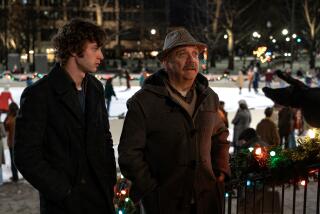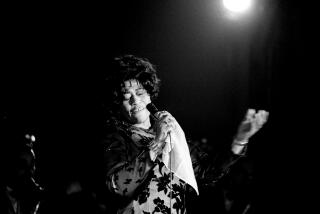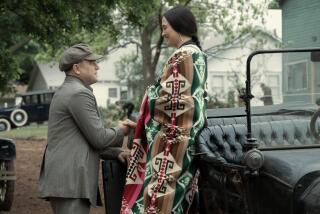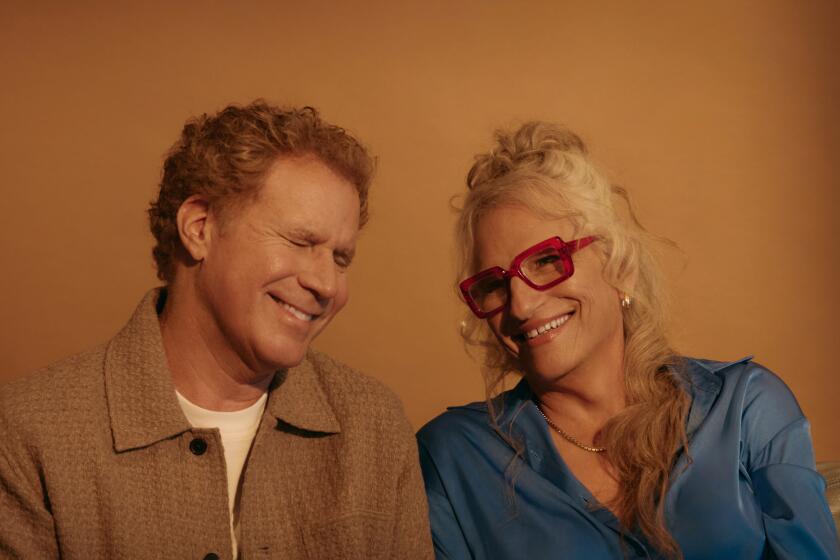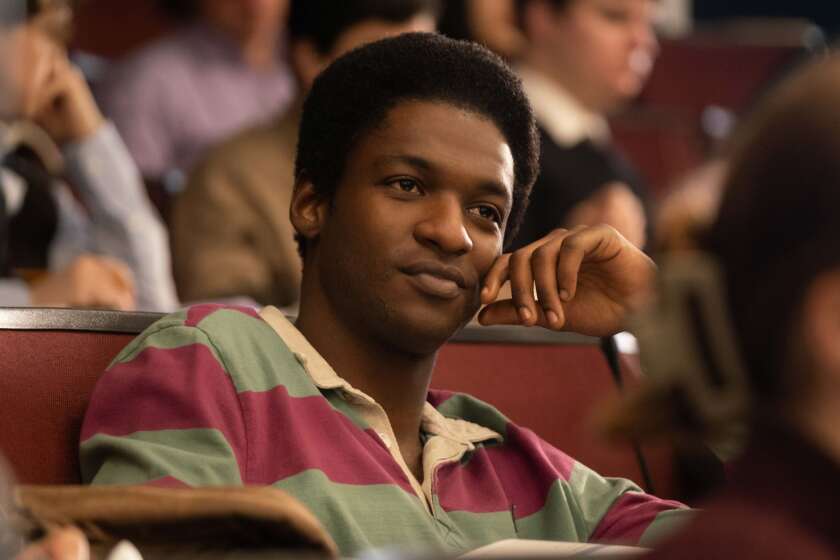Accepting this ‘Great Gatsby’ on its own terms
To judge by some of the reviews of the new film adaptation of “The Great Gatsby,” you’d think Australian director Baz Luhrmann would be facing extradition for his crime against an American classic.
But I have a message for all those self-appointed protectors of F. Scott Fitzgerald’s indelible novel: The book doesn’t need your condemnation of this supposed 3-D travesty to survive. If it can live through the tedium of Jack Clayton’s 1974 movie version with Robert Redford and Mia Farrow, it can live through anything.
Much as I was expecting to loathe Luhrmann’s cinematic Tilt-A-Whirl, I wound up (firing squad, prepare to load) enjoying the ride. How could this happen?
PHOTOS: ‘The Great Gatsby’ premiere
As a theater critic who liked “Gatz,” Elevator Repair Service’s marathon stage rendition of the novel, a no-frills production that was above all a celebration of Fitzgerald’s exquisite prose and the imaginative act of reading, I knew that I wasn’t the target audience. (The ubiquitous ads, with Leonardo DiCaprio and starry company arrayed against an Art Deco backdrop in postures reminiscent of an Irwin Shaw miniseries, might have come with a skull and crossbones attached, as far as I was concerned.)
My fears seemed fully realized as my eyes tried to adjust to the CGI-enhanced opulence of Luhrmann’s relentlessly bouncy film: This was, indeed, the anti-”Gatz.”
But something happened along the way that allowed me to accept this “Gatsby” on its own outlandishly Luhrmann terms, to regard the film not as a botched translation but as a diverting pop-cultural riff that has as much to say about Fitzgerald’s novel as it does about the connection between two decadent eras, the Jazz Age and our own.
The hip-hop-inflected soundtrack, which has executive producer Shawn “Jay-Z” Carter’s fingerprints all over it, freed me from the expectation of highly polished literary realism. If you can’t make the conceptual leap of a “Gatsby” movie featuring tracks by Beyoncé, Andre 3000 and Lana Del Rey, then by all means stay away.
But a literal-minded re-creation of “Gatsby” would probably have been as stultifying as one of those Shakespeare revivals in which every effort is made to duplicate our sketchy historical notions of Elizabethan stagecraft.
PHOTOS: The Roaring ‘20s on-screen
Theater directors take liberties on a regular basis with canonical texts, understanding that to recapture the energy and impact of a treasured work in a new form, reinvention is a necessity, not an indulgence. Playwrights, of course, are writing expressly for the stage, but their work still must be transposed from the page.
No production I’ve attended of “Hamlet” — and I’ve attended enough for several lifetimes — has been as complete as Shakespeare’s play. And no portrayal of the melancholy Dane has ever been as psychologically complex as the figure who has soliloquized before my mind’s eye.
The great Romantic critic William Hazlitt makes the point in an essay on “Hamlet,” in which he argues that the character, consisting of “speeches and sayings” that are but “the idle coinage of the poet’s brain” is only “as real as our own thoughts. ... It is we who are Hamlet.”
Of course, “we” is not a static entity. As Virginia Woolf once observed, “To write down one’s impression of ‘Hamlet’ as one reads it year after year, would be virtually to record one’s own autobiography....”
One of the tests of a classic is whether it presents itself as a mirror for each new generation that encounters it. Masterpieces, in short, are for re-reading. We don’t consume them; they consume us. Our relationship to them, individually and collectively, is ongoing, never to be completed.
This doesn’t mean that there aren’t good and bad responses to “Gatsby” or superior and inferior dramatizations. But it is very unlikely that a “Gatsby” film will ever replace the novel. And those who truly love the book can take comfort in the fact that the full experience is only a paperback away.
REVIEW: ‘Gatsby’s’ substance overwhelmed by Luhrmann’s style
This latest cinematic crack at “Gatsby” certainly gives us much to criticize, but the way in which reviewers have impatiently dismissed the film, adopting the tone of aggrieved consumers sold a phony bill of goods, is disappointing. Blinded by the superficial glitz of the movie, they have given short shrift to the depth of engagement with the novel that informs even the bad choices Luhrmann has made with his screenwriting collaborator, Craig Pearce.
The film has been described as a “Gatsby” made by Gatsby, a parvenu work of ostentatious taste and Donald Trump-like sensibility. At the same time, the movie has been chided for making the Jazz Age look spectacularly unalluring, a party in which no expense has been spared and no one appears to be having all that much fun.
It seems to me that this is precisely what Luhrmann was aiming for. This is his solution to the problem of dramatizing a work that tells its story better than it shows it. The ambivalent vision of Fitzgerald’s book, it’s important to remember, is conveyed through Nick Carraway’s first-person narration, something that a film can’t wholly accommodate.
The frame that Luhrmann and Pearce set up of having Tobey Maguire’s Nick, institutionalized for alcoholism, write his story as a form of therapy, is the weakest element of the adaptation. No actor could embody Nick’s authorial perceptiveness and brokenhearted tenderness, and Maguire, good at communicating an outsider’s longing for connection, strains when having to portray the soul weariness of the older Nick.
Lionel Trilling is hardly the only literary critic to point out that in “Fitzgerald’s work, the voice of his prose is of the essence of his success.” A film can intimate this quality — and Luhrmann pays homage to it not just through voice-overs but through whole sentences dancing from Nick’s manuscript onto the screen — yet cannot replicate it.
Luhrmann’s aesthetic may not be a natural match for what Trilling called Fitzgerald’s “characteristic modesty” and “stateliness.” But Luhrmann succeeds in a number of ways, most importantly in reminding us that behind Fitzgerald’s critique of the American dream is a doomed love story.
PHOTOS: ‘The Great Gatsby’ premiere
I have never been a huge DiCaprio fan, but has the alienated charm of this movie star ever been deployed to better effect? Outwardly gleaming, his Gatsby is inwardly crushed by losing Daisy (Carey Mulligan) to old-money brute Tom Buchanan (Joel Edgerton). The West Egg palace that Gatsby has built is a monument to an American acquisitiveness born out of rejection. No wonder all his lavish parties seem to leave him at such a loss.
Because Fitzgerald’s book is such a popular choice of English teachers, there’s a false assumption that the characters must be highly developed. They aren’t. Many operate as symbols or (to use Trilling’s term) “ideographs,” representatives of a social class or a category of person. Their complexity comes not through their self-awareness but through Nick’s deepening understanding of how the puzzle pieces of their actions fit together into a startling national portrait.
Beyond DiCaprio’s Gatsby, the standout performance in the film is Edgerton’s Tom, the gruff incarnation of aristocratic masculinity. Mulligan has been faulted for being a little too earthbound for ethereal Daisy, but of course her idealization exists principally in Gatsby’s mind.
What both Edgerton and Mulligan bring to their roles, particularly in the climactic scene at the Plaza Hotel, where Gatsby confronts Tom with the news of his rekindled love affair with Daisy, is a lucidity into the way the weaknesses of their “careless” characters interact with their class privilege. Here the psychology of Fitzgerald’s plot is granularly delineated.
Catherine Martin’s production design lays out the geography of the novel in a storybook fashion not locatable on any map but true to the imaginative scheme. This is a realm that exists in the fictive now, a landscape to be motored through at top speed with Jay-Z and company providing neo-jazzy reminders of how current the “Gatsby” milieu remains.
In another couple of decades “The Great Gatsby” will no doubt live again on screen, possibly in a tamer form more faithful to the memory of readers, many of whom lost their virginity to adult literature with this book. But that experience is readily recaptured in a solitary afternoon.
Luhrmann can be held to account for many missteps, but his boldness is refreshing. If some critics feel the need to punish him for not indulging their nostalgia, it’s heartening to see moviegoers eager to experience “Gatsby” anew.
More to Read
Only good movies
Get the Indie Focus newsletter, Mark Olsen's weekly guide to the world of cinema.
You may occasionally receive promotional content from the Los Angeles Times.
